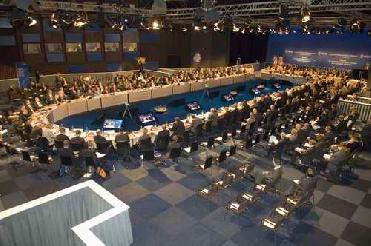
New Horizons Long Range Reconnaissance Imager took this 2-millisecond exposure of Jupiter on January 24, 2007. On the right are the two moons Io (bottom) and Ganymede. NASA photo
WASHINGTON (BNS): Jupiter has a rocky core that is 14 to 18 times the mass of Earth or about one-twentieth of Jupiter's total mass, according to computer calculations by a University of California, Berkeley geophysicist.
In a study published in the November 20 issue of Astrophysical Journal Letters, geophysicist Burkhard Militzer who simulated conditions inside the planet on the scale of individual hydrogen and helium atoms said, the simulation predicts the properties of hydrogen-helium mixtures at the extreme pressures and temperatures that occur in Jupiter's interior. However, this cannot be studied with laboratory experiments, he said.
Explaining the process, Militzer, an assistant professor of earth and planetary science and astronomy, said that he calculated the properties of hydrogen and helium for temperature, density and pressure at the surface all the way to the planet's centre. It is said that co-author William B. Hubbard, professor of planetary sciences at the University of Arizona's Lunar and Planetary Laboratory in Tucson, used the theoretical data to build a new model for Jupiter's interior.
"A comparison of this model with the planet's known mass, radius, surface temperature, gravity and equatorial bulge implies that Jupiter's core is an Earth-like rock 14 to 18 times the mass of Earth, or about one-twentieth of Jupiter's total mass," Militzer said. Previous models predicted a much smaller core of only 7 Earth masses or no core at all, he said.
The geophysicist said that the simulation suggests the core is made of layers of metals, rocks and ices of methane, ammonia and water, while above it is an atmosphere of mostly hydrogen and helium. At the centre of the rocky core is probably a metallic ball of iron and nickel, just like Earth's core.
Militzer said that their simulations showed a big rocky object in the centre surrounded by an ice layer and hardly any ice elsewhere in the planet. "This is a very different result for the interior structure of Jupiter than other recent models, which predict a relatively small or hardly any core and a mixture of ices throughout the atmosphere," Militzer said.
"Basically, Jupiter's interior resembles that of Saturn, with a Neptune or Uranus at the centre. Neptune and Uranus have been called 'ice giants' because they also appear to have a rocky core surrounded by icy hydrogen and helium, but without the gas envelope of Jupiter and Saturn," he said.
Giving his side of the view, Hubbard said that the new calculation by Burkhard removes a lot of old uncertainties of the 19-year-old model which one had been following to date. "The new thermodynamic model is a more precise physical description of what's going on inside Jupiter," Hubbard said.
The large, rocky core implies that as Jupiter and other giant gas planets formed 4.5 billion years ago, they grew through the collision of small rocks that formed cores that captured a huge atmosphere of hydrogen and helium.
"According to the core accretion model, as the original planetary nebula cooled, planetesimals collided and stuck together in a runaway effect that formed planet cores. If true, this implies that the planets have large cores, which is what the simulation predicts. It is more difficult to make a planet with a small core," Militzer said.
In order to match the observed gravity of Jupiter, Militzer's simulation also predicts that different parts of Jupiter's interior rotate at different rates. Jupiter can be thought of as a series of concentric cylinders rotating around the planet's spin axis, with the outer cylinders - the equatorial regions - rotating faster than the inner cylinders. This is identical to the Sun's rotation, Militzer said.
Militzer modeled Jupiter's interior as a collection of 110 hydrogen and nine helium atoms in a tiny cube that is replicated throughout the planet, a common approximation in 'density functional theory'. The ratio of hydrogen to helium atoms approximates the ratio measured on the surface of Jupiter. Each simulation took from one to seven days on parallel computing clusters.
The new model of Jupiter predicts that most of the ices are concentrated in the outer layer of the core, while only a small amount is mixed in the hydrogen-helium gas envelope that contains 95 per cent of the planet's mass. The 'planetary ices' in the envelope amount to about four Earth masses, or 1 per cent of Jupiter's mass, Militzer said.
"Jupiter formed beyond the ice line and so accreted ice along with the rocky material," he said, adding that as a result, the ice is part of the core and is not in the envelope.
"The simulation was in pretty good agreement with what the Galileo probe measured when the NASA spacecraft descended through Jupiter's atmosphere in 1995," Hubbard said.
It is said that future data from NASA's Juno mission, to be launched in 2011 and orbit Jupiter by 2016, will measure the planet's magnetic field and gravity and provide a check on Militzer's predictions. The scientist also plans to use the new model to simulate other planets' interiors, and investigate the implications for the formation of planets outside the solar system.
 Previous Article
Previous Article Next Article
Next Article












The Indian Air Force, in its flight trials evaluation report submitted before the Defence Ministry l..
view articleAn insight into the Medium Multi-Role Combat Aircraft competition...
view articleSky enthusiasts can now spot the International Space Station (ISS) commanded by Indian-American astr..
view article